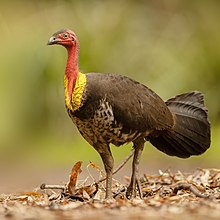Pangalloanserae
| Pangalloanserae | |
|---|---|

| |
| Australian brushturkey (Alectura lathami) | |
| Scientific classification | |
| Kingdom: | Animalia |
| Phylum: | Chordata |
| Class: | Aves |
| Infraclass: | Neognathae |
| Clade: | Pangalloanserae Gauthier and de Queiroz, 2001 |
| Subgroups | |
| |
| Synonyms | |
|
Pananatophasianae | |
Pangalloanserae is a clade of birds defined in a 2001 study by Jacques Gauthier and Kevin de Queiroz as "most inclusive clade containing Galloanserae but not Neoaves". It contains crown Galloanserae as well as all stem-galloanserans.[3][4]
References[]
- ^ Field, Daniel J.; Benito, Juan; Chen, Albert; Jagt, John W. M.; Ksepka, Daniel T. (March 2020). "Late Cretaceous neornithine from Europe illuminates the origins of crown birds". Nature. 579 (7799): 397–401. doi:10.1038/s41586-020-2096-0. ISSN 0028-0836. PMID 32188952.
- ^ Kuhl., H.; Frankl-Vilches, C.; Bakker, A.; Mayr, G.; Nikolaus, G.; Boerno, S. T.; Klages, S.; Timmermann, B.; Gahr, M. (2020). "An unbiased molecular approach using 3'UTRs resolves the avian family-level tree of life". Molecular Biology and Evolution: 143. doi:10.1093/molbev/msaa191.
- ^ Gauthier, Jacques; de Queiroz, Kevin (2001). "Feathered Dinosaurs, Flying Dinosaurs, Crown Dinosaurs and the Names "Aves"". Cite journal requires
|journal=(help) - ^ Field, Daniel J.; Benito, Juan; Chen, Albert; Jagt, John W. M.; Ksepka, Daniel T. (March 2020). "Late Cretaceous neornithine from Europe illuminates the origins of crown birds". Nature. 579 (7799): 397–401. doi:10.1038/s41586-020-2096-0. ISSN 1476-4687.
Categories:
- Neognathae
- Extant Maastrichtian first appearances